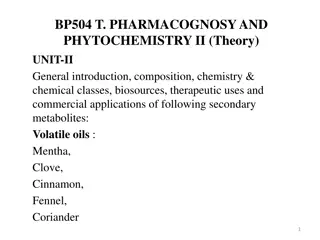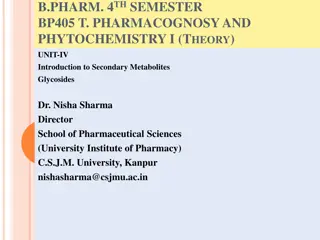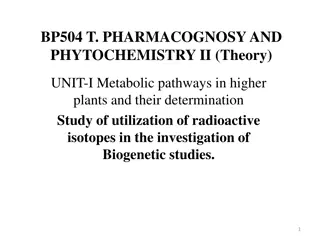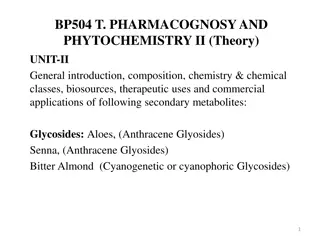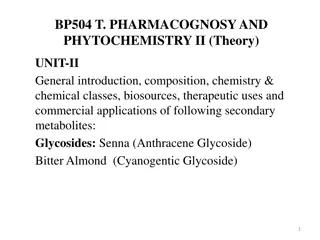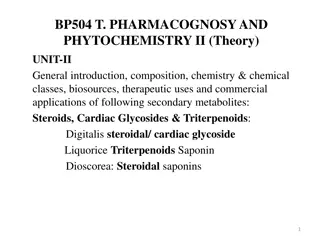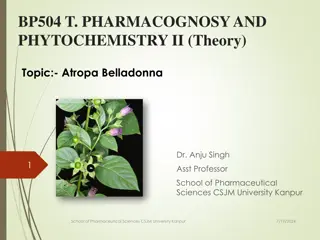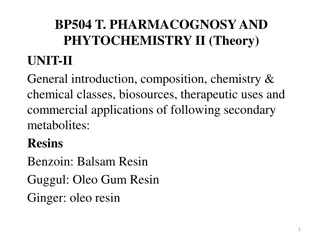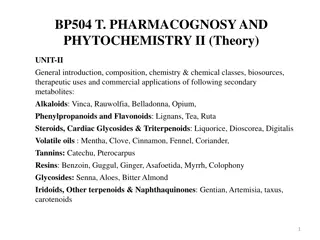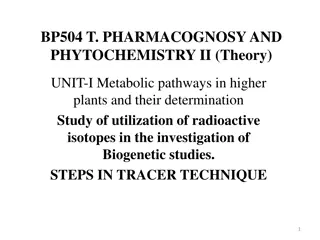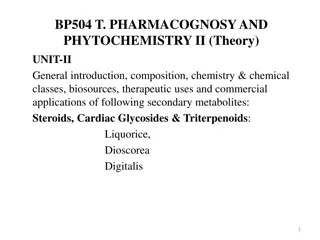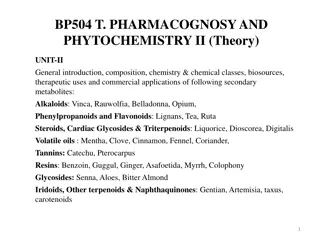Volatile Oils in Pharmacognosy and Phytochemistry: Composition, Chemistry, Uses
Volatile oils, also known as essential oils, are derived from terpenes and their oxygenated compounds. These oils possess characteristic odors and are extracted from plants through various methods like hydro-distillation and steam distillation. They are commonly used as flavoring agents, perfumes, a
0 views • 29 slides
Sources of Crude Drugs: Plant, Animal, Marine, and Tissue Culture in Pharmacognosy
Crude drugs are natural substances obtained from plants, animals, and minerals. They are used without much processing and have therapeutic properties. Different plant parts like leaves, flowers, fruits, seeds, roots, bark, and stems yield various important drugs. Animals and minerals also serve as s
1 views • 19 slides
Understanding Glycosides: Secondary Metabolites in Pharmacognosy
Glycosides are naturally occurring compounds with sugar and non-sugar components. They are characterized by glycosidic bonds and can be chemically separated. These compounds exhibit various physical and chemical properties, including solubility, taste, and optical activity. Classification based on g
1 views • 11 slides
Techniques for Investigating Plant Metabolic Pathways and Biogenetic Studies
This content explores various techniques used in pharmacognosy and phytochemistry to investigate the metabolic pathways in plants and study the formation of primary and secondary metabolites. Methods such as utilizing radioactive isotopes, tracer techniques, isolated organs/tissues, grafting, and mu
4 views • 12 slides
Understanding Anthracene Glycosides in Pharmacognosy and Phytochemistry
Anthracene glycosides are secondary metabolites found in various plant families, offering therapeutic benefits. This comprehensive study explores their composition, chemistry, biosources, and applications, detailing the structural variations of aglycones and sugars present in these compounds. Method
0 views • 30 slides
Comparison of Alexandrian Senna and Indian Senna: Pharmacognosy and Phytochemistry Insights
Explore the pharmacognosy and phytochemistry of Alexandrian Senna and Indian Senna, detailing their collection, preparation, macroscopic and microscopic characteristics, chemical constituents, and potential adulterants. Learn about the therapeutic applications and commercial significance of these gl
0 views • 30 slides
Pharmacognosy and Phytochemistry II: Secondary Metabolites and Their Therapeutic Applications
This unit delves into the composition, chemistry, therapeutic uses, and commercial applications of secondary metabolites such as steroids, cardiac glycosides, and triterpenoids. It explores the properties of saponin glycosides, their classification based on aglycone nature, and the significance of s
0 views • 23 slides
Pharmacognosy and Phytochemistry II: Atropa Belladonna Overview
Atropa belladonna, commonly known as belladonna, is a plant rich in tropane alkaloids like atropine and scopolamine. This plant, belonging to the Solanaceae family, has various medicinal uses. Its distinct morphology and geographical sources make it a significant botanical specimen in pharmacognosy
0 views • 13 slides
Understanding Resins: Composition, Occurrence, and Classification
Resins are solid/semisolid amorphous products with complex chemical composition and are found in plants, animals, and fossils. They contain essential oils, terpene products, and carboxylic acids. Resins occur as a result of normal metabolism or in response to injury, forming physiological or patholo
1 views • 37 slides
Overview of Rauwolfia Alkaloids and Therapeutic Uses
Rauwolfia is a plant known for its alkaloids like Reserpine, Deserpine, and Ajmaline, with therapeutic applications in treating insanity and snake bites. These alkaloids are indole-based and occur in the roots of Rauwolfia plants. Reserpine, one of the major alkaloids, is a pale crystalline substanc
1 views • 13 slides
Exploring Radio Tracer Techniques in Pharmacognosy and Phytochemistry II
In this unit, the focus is on metabolic pathways in higher plants and leveraging radioactive isotopes for biogenetic studies. Topics covered include steps in tracer techniques, selection of radioisotopes, preparation of labeled compounds, and insertion of radio-labeled metabolites in plant parts usi
0 views • 9 slides
Understanding Cardiac Glycosides in Pharmacognosy and Phytochemistry
Explore the role of Steroids, Cardiac Glycosides, and Triterpenoids in pharmacognosy and phytochemistry, focusing on their general introduction, composition, chemistry, biosources, therapeutic uses, and commercial applications. Learn about the structure and attachment of sugar parts in Cardiac Glyco
9 views • 9 slides
Overview of Indole Alkaloids in Pharmacognosy and Phytochemistry II
Indole alkaloids are a significant group of naturally occurring compounds with diverse chemical structures and physiological actions. This unit delves into the general introduction, composition, chemistry, biosources, therapeutic uses, and commercial applications of various secondary metabolites, in
0 views • 17 slides
